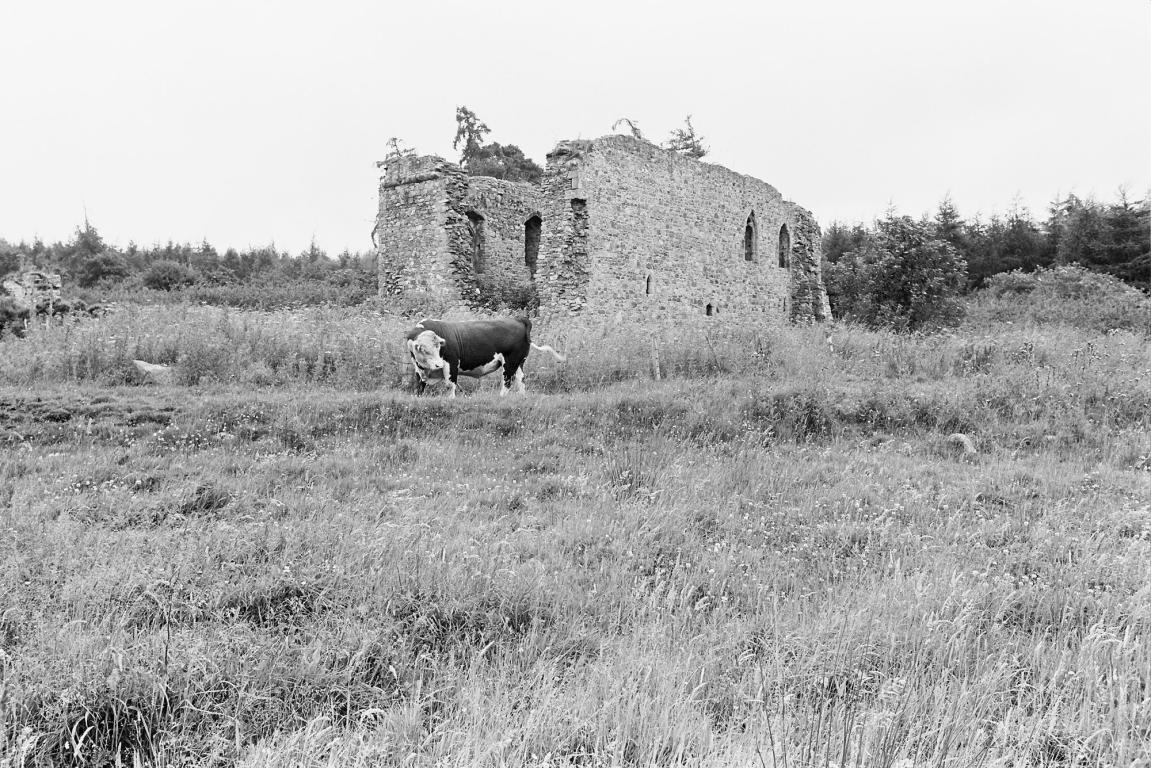
Rait Castle
By Melissa Davies
This story belongs to a ten-part series of stories gifted by Nairn Museum. Many thanks to Melissa Davies, the director of Nairn Museum, for kindly gifting these stories to the Spirit: Stories archive.
Rait Castle stands a couple of miles south of Nairn at the foot of Ord Hill. Tales of romance, treachery, murder and a handless ghost haunt its ruins. It was built as a hall-house castle, and dates from the 13th century. It is unusual as it has gothic windows with red sandstone mullions (divisions between units of a window). The 9 feet high remains of the courtyard walls and remains of the Chapel of St Mary of Rait can be seen. It was originally a two story building and had an unvaulted basement and upper hall. The walls are nearly 6 feet thick. There is also a tower at one corner and the ruins of a projecting garde-robe at the north west corner. The castle originally belonged to the Comyn (or Cummings) family and they took the name of de Rait.
During the Wars of Independence, Sir Andrew de Rait took the side of Edward I of England while the Mackintoshes sided with Robert the Bruce. The Mackintoshes felt they rightfully owned Rait and revived their claim to it. Following several skirmishes in which the Cummings came off second best, the chief decided on a plan in which he would invite the Mackintoshes to a feast at the castle to declare a bond of friendship and bury former animosities. However, his real intention was that after the 'Toast to the Memory of the Dead' was given, the secretly armed Cummings would murder their guests. The invitation was accepted and the Mackintoshes prepared to attend. However, they were warned about Cummings' foul plot, and were prepared.
Cumming had put his household under solemn oath that they would not reveal the plot, but his daughter, who was anxious for the safety of her lover, a young Mackintosh, found a way to disclose the plot. She went to a large boulder near the castle and told the story to the stone, but she knew her lover was behind it as it was their usual meeting place. The stone to this day is known as 'The Stone of the Maiden'. The Mackintoshes resolved to attend the feast. According to Bain's History of Nairnshire, each Mackintosh hid his dirk in his plaid, and when 'the signal was given for the slaughter of the guests, the Cummings rose to draw their swords but the forearmed Mackintoshes drew their daggers and thrust them into the hearts of the Cummings'. Among the few to escape was the chief of the Cummings who suspected his daughter of the treachery. The story goes that he chased her to her bedroom where she tried to escape through the window, but he cut off her hands with his sword and she fell to her death below.
Ever since then, Rait Castle has never been occupied and came into the possession of the Cawdor family in 1442. It is said that the castle is haunted by the daughter of Cummings and that she appears at dusk in a blood-stained dress, wandering aimlessly around the ruin with bloody stumps for hands.
The final verse of the poem, 'The Legend of Rait', from Nairnshire Ballads reads:
'Long ages have rolled since these curse-stricken towers
Have mouldered and crumbled, both rooftree and wall,
For lady since then hath not smiled in the bowers,
Nor warrior in wassail caroused in the hall;
But still by the fire on the lone wintery night,
With a sigh and a shudder the peasants relate
Dark legends of horror of phantom and sprite
That haunt in the darkness the Castle of Rait'
 Image provided by Am Baile
Image provided by Am Baile
The ruins of Rait Castle
We Want to Hear From You!
Share your stories and memories of Nairn
Stories are at the heart of what we do as a project and we are always looking to learn more about what the Highlands and Islands means to people who live, work, and visit here. Nairn is an iconic part of the Highlands, with a rich natural and cultural heritage to discover. We would love to know, what are some of your favourite memories or stories related to Nairn? Tell us below, we can't wait to hear from you!
Click here to share your story through our online story portal